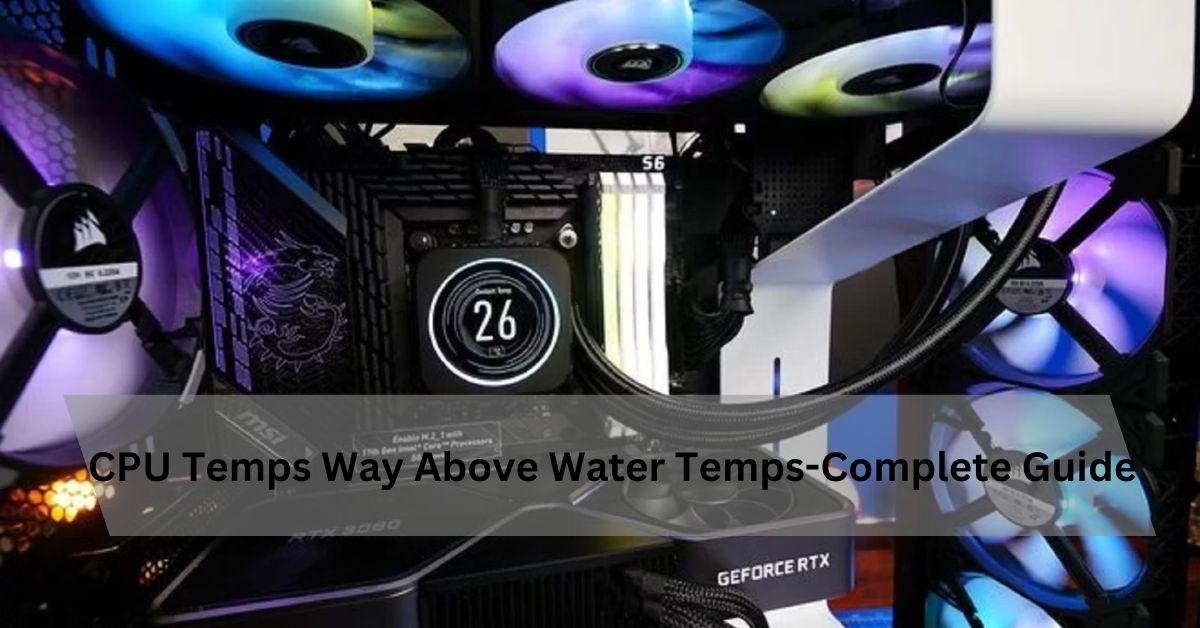To ensure the smooth operation of their systems, enthusiasts in the PC building field frequently strive for optimal performance and effective cooling.
However, there are instances in which CPU temperatures appear to exceed water temperatures, causing users to become confused and concerned.
The intricacies of cooling systems and potential solutions to the problem are examined in this article as we investigate the causes of this phenomenon.
Understanding Temperatures of the CPU and Water:
It is essential to comprehend the fundamentals before delving into the causes of the difference between CPU and water temperature. The focal handling unit (central processor) fills in as the mind of a PC, creating heat as it processes information and executes orders.
CPU’s need efficient cooling mechanisms to prevent damage and overheating. Water cooling is now widely used to keep CPU temperatures at their best. This technique includes coursing fluid coolant through a progression of cylinders and parts, scattering heat more effectively than conventional air cooling frameworks.
Water cooling regularly consists of a radiator, siphon, supply, and water block, giving an extensive cooling answer for elite execution computers. Users may experience situations in which CPU temperatures exceed water temperatures, causing confusion and frustration despite the effectiveness of water cooling.
This disparity is caused by a number of things, including the system’s configuration and the environment’s conditions.
Factors Adding to High CPU Temperatures:
1. Material for the Thermal Interface (TIM):
The utilization of warm glue or cushions between the computer processor and its cooler assumes a vital part in heat movement. Thermal conductivity can be hindered by poor application or TIM, resulting in elevated CPU temperatures.
2. Cooler Performance:
The design, size, and fan speed of CPU coolers affect their effectiveness. CPU temperatures may rise because inadequate cooling solutions struggle to dissipate heat efficiently.
3. Overclocking:
Overclocking their CPU’s to get better performance is shared among enthusiasts. Nonetheless, overclocking increases power utilization and intensity age, requiring hearty cooling to keep up with stable temperatures.
4. Framework Wind current:
To effectively cool components, the PC case must allow for adequate flow. CPU temperatures can rise due to impeded heat dissipation caused by improper cable management or blocked flow.
5. The temperature outside:
Large framework thermals influence the temperature of the general climate. More robust cooling solutions are required to counter heat buildup within the PC at higher ambient temperatures.
6. Thermal Stimulation:
Thermal throttling mechanisms are used in modern CPU’s to prevent overheating. At the point when temperatures surpass safe restrictions, the computer chip lessens its clock speed to moderate intensity age, possibly prompting execution debasement.
Also Read: Do I Need To Update BIOS For New CPU?-Complete Guide
Addressing the Discrepancy:

While CPU temperatures that are higher than water temperatures can be troubling, the following steps can alleviate the problem:
1. Replacing the Thermal Paste:
Reapplying great warm glue between the computer chip and cooler can improve heat move effectiveness, lessening central processor temperatures.
2. Cooling Solutions Upgrades:
Improved heat dissipation and lower temperatures can be achieved by upgrading to a larger radiator or investing in a cooler for a more effective CPU.
3. Improving Wind stream:
Through proper cable management and fan placement, adequate flow within the PC case can improve cooling performance and reduce temperature variations.
4. Monitoring and adjusting settings for overclocking:
Keeping stable CPU temperatures without sacrificing performance can be achieved by monitoring CPU temperatures while overclocking and adjusting voltage and frequency settings accordingly.
5. Environmental Factors to Consider:
A favorable environment for optimal PC cooling can be created by controlling ambient temperatures through adequate ventilation or air conditioning.
Also Read: Does Anyone Check Their CPU Temps?-A Complete Guide
Advanced Solutions and Considerations:

1. Further developed Cooling Framework:
Put resources into a more vigorous cooling answer for the computer chip, like an elite execution central processor cooler or fluid cooling framework. Liquid cooling systems can help lower CPU temperatures even when ambient temperatures are high because they typically have better heat dissipation capabilities.
2. Enhance Airflow:
Upgrade case wind current by adding extra fans or revising existing ones to guarantee proficient air course and intensity dispersal. Consider introducing fans with higher wind current or static tension evaluations to develop cooling execution further.
3. Undervolting:
Explore different avenues regarding undervolting the central processor to diminish power utilization and intensity age. Undervolting includes bringing down the computer processor voltage while keeping up with stable activity, which can assist with bringing down temperatures without forfeiting execution.
4. Replacement for the Thermal Interface Material (TIM):
Consider supplanting the stock warm glue or cushions with better warm mixtures to develop heat move between the computer chip and cooler. Superior execution of warm mixtures can assist with diminishing warm opposition and lower computer processor temperatures.
5. Delidding:
CPU Advanced users might consider upgrading the CPU to liquid metal or other high-performance compounds instead of the standard thermal interface material (TIM). In deciding, the integrated heat spreader (IHS) is removed so that the thermal compound can be applied directly to the CPU die, resulting in lower temperatures and improved thermal conductivity.
6. Ecological Control:
Reduce ambient temperatures using air conditioning or other cooling methods to improve the environment surrounding the computer. The high CPU temperatures about water temperatures can be lessened by lowering the ambient temperature.
7. Analysis and Monitoring of Hardware:
Monitor CPU temperatures, voltages, and other performance metrics over time with hardware monitoring tools. Break down temperature drifts and recognize expected bottlenecks or issues that might add to unreasonably high computer chip temperatures compared to water temperatures
8. Framework Streamlining:
Enhance framework settings and designs to decrease computer processor responsibility and intensity age. Changing power settings, stopping background processes that aren’t necessary, or optimizing software to use as little CPU as possible are all examples of this.
9. Consider the Compatibility of Components:
Check that the CPU cooler, case fans, and liquid cooling components (if any) are compatible and installed correctly. CPU temperatures can rise as a result of components that are not compatible or that have been installed incorrectly.
10. Consultation from a professional:
If nothing else works, professional computer technicians or thermal management specialists can provide individualized recommendations and solutions tailored to your specific hardware configuration and cooling requirements.
Also Read: Test A CPU Without Thermal Paste-Complete Guide
FAQ’s:
1. What happens if CPU temperature exceeds maximum?
Supported computer processor temps above 80°C (176°F) can cause long-term harm to the computer chip and its silicon.
2. When using water cooling, what temperature should a CPU be at?
Under fluid cooling, computer chips regularly have out-of-gear fevers between 25°C and 35°C.
3. Is CPU water cooling beneficial?
Indeed, it’s more productive and frequently calmer.
4. Can I cool my CPU with water?
Fluid cooling or water cooling is one of the most mind-blowing ways of chilling off a PC because of the tremendous warm conductivity of water.
Conclusion:
In PC building, keeping up with ideal temperatures is the principal factor in framework soundness and life span. While experiencing high computer chip temperatures compared with water temperatures may, at first, pose difficulties, figuring out the hidden factors and executing suitable arrangements can alleviate the issue.
Users can reduce the risk of overheating their personal computers by optimizing cooling systems, keeping an eye on thermals, and considering the surrounding environment.



